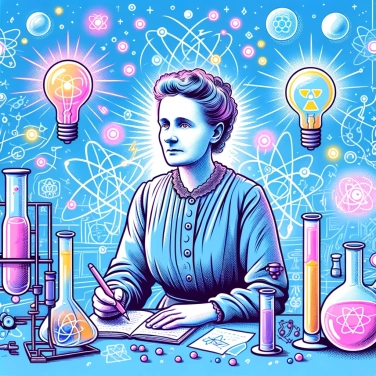Marie Curie chose to study radioactivity because she was fascinated by the mysterious properties of radioactive materials, such as uranium and radium, and she spent her life exploring this scientific phenomenon in order to better understand it.

Marie Curie grew up in a Poland occupied by the Russian Empire, with significant restrictions placed on education, particularly for women. From a young age, she developed a strong taste for science thanks to her father, a professor of physics and mathematics. Later, settled in Paris to study at the Sorbonne, Marie immersed herself in a stimulating academic environment, rich in scientific discoveries. In Paris, she met the decisive figure of her future husband, Pierre Curie, who shared her scientific passion. Together, they formed a research team that was both collaborative and complementary. The family context, marked by the premature deaths of her mother and sister, likely also contributed to reinforcing in Marie a strong desire for intellectual independence and an exceptional determination to succeed in science.
At the time of Marie Curie, everyone was talking about X-rays, which had been discovered shortly before by Wilhelm Röntgen. Shortly after that, Henri Becquerel accidentally noticed that a uranium ore naturally emitted strange radiations capable of darkening photographic plates. It was this intriguing discovery, still very fresh, that strongly attracted Marie Curie's attention. Fascinated by these mysterious phenomena, she decided to dig deeper, starting directly from Becquerel's work to explore this new field that she would later name radioactivity. She wanted to understand how and why certain minerals spontaneously emitted these strange rays capable of passing through matter. This need to explain a recent and totally inexplicable discovery drove her to take action. It was primarily the previous research of Röntgen and Becquerel—and their somewhat mysterious nature—that sparked a scientific obsession in her for this subject.
Marie Curie had a particular fascination for understanding the mysterious phenomena that others could not clearly explain. When she found that the radiations emitted by certain substances completely defied the known laws of the time, her curiosity was greatly awakened. She was determined to find out where these strange rays came from, why they passed through certain materials, and why they made the air capable of conducting electricity. Testing, experimenting, measuring: she tirelessly threw herself into endless sessions in the laboratory, sometimes at night, to further her knowledge. This constant desire to discover the unknown and unveil the hidden secrets of matter drove her to thoroughly explore the subject of radioactivity and ultimately led to revolutionary discoveries.
Marie Curie was fascinated by the enormous potential that radioactivity had in medicine, particularly for better understanding and treating diseases like cancer. Even in her time, she sensed that radioactive elements could be used to observe the inside of the human body and to destroy tumor cells. But she also looked further, into industrial possibilities. She imagined that using these substances to create new technologies, such as highly precise measuring devices or innovative industrial treatments, would open up countless useful doors for society. Her intuition was right; today, radioactivity is regularly used in hospitals for medical imaging and radiotherapy, but also in very diverse industries, such as food preservation or defect detection in certain materials.
The term 'radioactivity' was invented by Marie Curie herself. In seeking to describe the surprising properties of certain elements, she introduced this term into the scientific community, a term that is still used today.
Despite her eminent scientific contributions, Marie Curie never filed patents for her discoveries. She believed that scientific knowledge should be shared freely for the benefit of all humanity.
During World War I, Marie Curie created the first mobile medical imaging units, known as 'Little Curies'. These units allowed for X-rays to be taken directly on the battlefields, helping to save many lives.
Marie Curie is the first woman to have won a Nobel Prize, and she remains the only person, man or woman, to have received two Nobel Prizes in two different scientific fields: Physics in 1903 and Chemistry in 1911.
Marie Curie chose the name 'polonium' in homage to her homeland, Poland, which was occupied at the time by various foreign powers. This was a symbolic way for her to pay tribute to her origins.
Marie Curie's research led to groundbreaking advancements in the medical field, particularly in medical imaging and cancer treatment through radiotherapy. During World War I, she actively contributed by developing mobile radiological imaging units to assist the medical corps in locating and treating war injuries.
Marie Curie and her husband were initially unaware of the potential dangers of radioactive substances. Their daily handling of these materials without protection led to significant exposure to radiation. This cumulative exposure likely contributed to the health issues that Marie Curie later suffered, ultimately resulting in her death from aplastic anemia.
The discovery of radioactivity revolutionized several industrial sectors. It notably enabled the development of new industrial techniques, such as non-destructive testing processes to detect structural defects or assess the integrity of materials, as well as improvements in medical diagnostics and other innovative therapeutic treatments.
Marie Curie, alongside her husband Pierre Curie, undertook extensive experiments after being inspired by the pioneering work of Henri Becquerel. By analyzing different substances to understand the nature of the radiation observed by Becquerel, she discovered two new radioactive elements: polonium and radium.

No one has answered this quiz yet, be the first!' :-)
Question 1/5